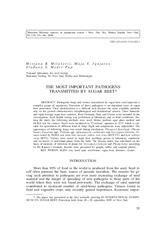Приказ основних података о документу
The most important pathogens transmitted by sugar beet
Ekonomski najznačajniji paraziti koji se prenose semenom šećerne repe
| dc.creator | Milošević, Mirjana | |
| dc.creator | Ignjatov, Maja | |
| dc.creator | Medić-Pap, Slađana | |
| dc.date.accessioned | 2022-05-11T08:41:41Z | |
| dc.date.available | 2022-05-11T08:41:41Z | |
| dc.date.issued | 2006 | |
| dc.identifier.issn | 2406-0828 | |
| dc.identifier.issn | 0352-4906 | |
| dc.identifier.uri | http://fiver.ifvcns.rs/handle/123456789/2640 | |
| dc.description.abstract | Pathogenic fungi and viruses transmitted by sugar beet seed represent a complex group of organisms. Detection of these pathogens is an important issue in sugar beet protection. Their identification is a difficult task because the most available methods rely on the growth characteristics and morphological and biochemical criteria. Three domestic and eight foreign sugar beet varieties, from Germany, Italy, and Greece were included in the investigation. Seed health testing was performed in laboratory and in field conditions. During the trials, the following methods were used: blotter method, agar plate method and ELISA test for viruses. Seeds were incubated in “Conviron" aparatus at 22°C which is suitable for sporulation of different kind of fungi (light and temperature were adjustable). The appearance of following fungi was noted during incubation: Pleospora bjoerlingii (Phoma betae), Fusarium spp., Pythium spp. Aphanomyces cochlioides and Cercospora beticola. Viruses tested by ELISA test were beet necrotic yellow vein virus (BNYVV) and beet yellows virus (BYV). Viruses were tested in sugar beet seedlings grown in laboratory conditions and on leaves of individual plants from the field. The disease index was calculated on the basis of the intensity of infection of plants for Cercospora beticola and Phoma betae according to Mc Kinney's formula. Results were presented by graphs, tables and original photos. | sr |
| dc.description.abstract | Patogene gljive i virusi koji se prenose semenom šećerne repe predstavljaju kompleksnu grupu organizama. Ispitivanje ovih patogena je veoma značajno u zaštiti šećerne repe. Njihova identifikacija je dosta složena zbog toga što se mnoge dostupne metode odnose na karakteristike porasta, morfološke i biohemijske osobine. U ispitivanja su bile uključene tri domaće i osam stranih sorti šećerne repe poreklom iz Nemačke, Italije i Grčke. Ogledi su izvedeni u laboratoriji i u polju. Zdravstveno stanje semena određivano je u laboratorijskim uslovima. U toku rada korišćene su sledeće metode: filter papir metod, metod hranljive podloge i ELISA test na prisustvo virusa. | sr |
| dc.language.iso | en | sr |
| dc.publisher | Novi Sad : Matica srpska | sr |
| dc.rights | openAccess | sr |
| dc.rights.uri | https://creativecommons.org/licenses/by-nc-nd/4.0/ | |
| dc.source | Zbornik Matice srpske za prirodne nauke | sr |
| dc.subject | ELISA test | sr |
| dc.subject | leaf spot | sr |
| dc.subject | seed borne | sr |
| dc.subject | sugar beet | sr |
| dc.subject | diseases | sr |
| dc.subject | viruses | sr |
| dc.subject | šećerna repa | sr |
| dc.subject | bolesti | sr |
| dc.subject | virusi | sr |
| dc.subject | zdravstveno stanje semena | sr |
| dc.subject | seed health | sr |
| dc.title | The most important pathogens transmitted by sugar beet | sr |
| dc.title | Ekonomski najznačajniji paraziti koji se prenose semenom šećerne repe | sr |
| dc.type | article | sr |
| dc.rights.license | BY-NC-ND | sr |
| dc.citation.epage | 64 | |
| dc.citation.spage | 55 | |
| dc.citation.volume | 110 | |
| dc.identifier.fulltext | http://fiver.ifvcns.rs/bitstream/id/7174/0352-49060610055M.pdf | |
| dc.identifier.rcub | https://hdl.handle.net/21.15107/rcub_fiver_2640 | |
| dc.type.version | publishedVersion | sr |


